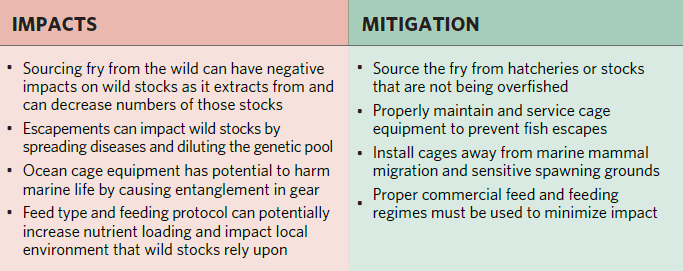Environmental Impacts & Benefits
Understanding and addressing environmental impacts and potential benefits of aquaculture in sensitive coral reef areas is essential for coral reef managers. The four major categories of environmental impacts and benefits are: wild stocks, habitat, water quality, and disease.
These four interrelated impacts can generally be addressed and mitigated through appropriate species selection, gear type, technology use, regulations that support sustainable management, environmental impact assessment, site selection and spatial planning approaches. ref Each of these impacts should be thoroughly discussed and researched during project planning and management to minimize risks. Key environmental impacts and mitigation strategies are described in detail below.
Wild Stocks
One of the main impacts aquaculture can have on wild stocks is the continuous extraction of species from the ecosystem. If extraction is unsustainable, the reproductive potential of species being removed will be negatively affected by not allowing enough animals to reach sexual maturity and spawn. Also, stock escapements can occur when the cage nets are not serviced properly and holes form, or due to poor practices during stocking, harvesting, or transfer of species. Farmed species can be released into the wild and potentially impact wild stocks by introducing diseases and diluting the genetic pool through interbreeding with wild populations. If proper maintenance and planning are carried out, holes in nets and stock escapements can be prevented. ref
In addition to impacts, some species of aquaculture, if properly managed and impacts are minimized, can either become fish aggregating devices (FADs) and/or even increase productivity of local species. The effect on the productivity of wild marine species due to aggregation versus recruitment and subsequent enhancement of populations varies, however there is evidence of increased production due to the presence of aquaculture facilities. ref The three-dimensional structure of aquaculture can also stabilize soft sediment, helping to reduce erosion or the impacts of extreme weather events (e.g., ref). Spawning aquaculture stock can also ‘spill over’ to wild populations, and while this effect has the potential to cause significant genetic diversity and/or local adaptation impacts on local populations, there is evidence that under the right circumstances, it can provide a beneficial subsidy to impacted populations, or stock enhancement for restoration efforts. ref
Habitat
The installation and operation of aquaculture infrastructure in coastal areas can have both direct and indirect impacts on habitat. Direct impacts can be in the form of displacement or removal of habitats to make space for the infrastructure, such as cutting mangroves for the construction of a dock or pier, or damage to corals and seagrass beds during the installation of cage anchors and weights. Aquaculture can also create habitat by providing three-dimensional structured habitat for fish and invertebrates. Proper farm siting needs to take place before the construction and installation of farm infrastructure to determine the optimal location while taking into account currents, tides, seafloor depth, and distance to sensitive habitats like coral reefs, mangroves, and seagrass beds. Indirect impacts to local habitats include damage to benthic communities and declining water quality from overfeeding. Proper feeding and stocking practices can help to mitigate negative impacts. ref
In addition to potential impacts, aquaculture gear and the organisms cultivated on and within them can also provide habitat provisioning benefits, when farmed in the right way. Seaweed and shellfish gear can provide three-dimensional structured habitat that can benefit fish and invertebrates - farms can provide refugia for juvenile fish and invertebrates, functioning in a similar way to natural nursery grounds. ref In addition, aquaculture organisms and biofouling communities associated with farms can provide food resources. ref In a global review of 65 studies, higher fish abundance and diversity were generally associated with bivalve and seaweed farms than nearby reference sites. ref The localized effects of reduced acidification and temperature created by seaweed farms can be beneficial to the provision of effective habitat (e.g., a refuge; ref).
Water Quality
Water quality in the surrounding area of the cage must be considered and monitored. For example, stocking and maintaining too many fish in a small space can lower the overall water quality by depleting oxygen levels and increasing nitrogen, phosphorus, and ammonia levels, which if allowed to pass a level that the environment cannot absorb or diffuse, can cause detrimental effects to the local area. Careful and diligent monitoring needs to take place before and after infrastructure has been installed to determine if water quality is degrading at the site.
Aquaculture also can improve nearshore water quality through filtration of water and suspended material, and enhanced cycling of nutrients. In particular, bivalves and seaweeds can often improve nearshore water quality at various scales, because species can remove nutrients (including nitrogen, phosphorous) via uptake in tissue and shell, which is then removed from the water body during harvest. ref
Disease
Like any other food production system, if too many animals are kept in a relatively small space and not given optimal conditions for health and growth, there can be outbreaks of diseases and parasites. Proper management needs to take into account stocking density, currents or tides to flush clean water in and waste out, high feed quality, standardized feeding protocols, and overall monitoring of stock behavior and health. As soon as any species begin displaying certain behavioral or physical traits that may indicate disease or parasites, correct and appropriate treatments need to take place in order to minimize mortalities. ref
The next sections describe the four major categories of environmental impacts in detail.




